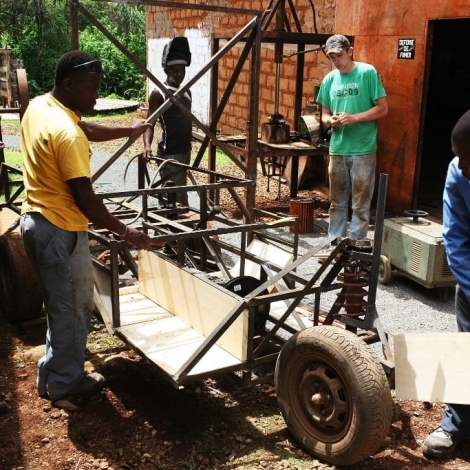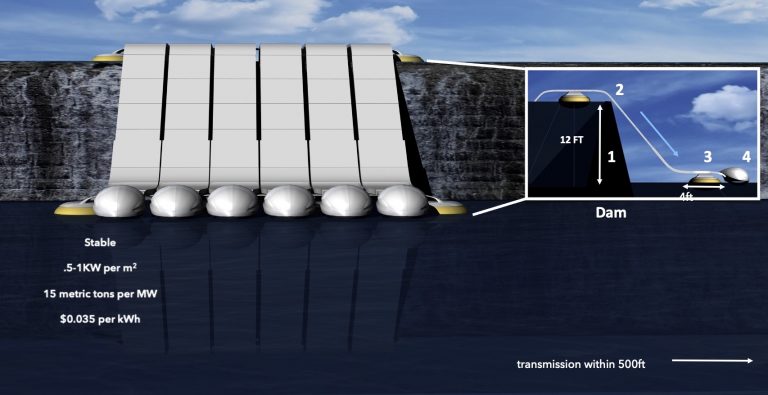If farmers in the west central African nation of Cameroon were to design a truck it might look something like this. A three-wheeled flatbed truck that bears the pragmatic name of Basic Utility Vehicle hauls loads on rough roads between farms, homes, wells and markets in rural Cameroon. In the near future, the BUV could also take on attachments that convert the vehicle into other useful tools such as a water pump or an agricultural food processor.
The BUV is so suited to the regions because the Cameroonians did have a hand in its design. Students from Purdue University in West Lafayette, Indiana, put their heads together with farmers from Bangang, Cameroon to create the vehicle [See also: Cameroonian tinkerers get schooled in DIY hydropower]. Now in its third prototype, the BUV meets parameters that the farmers set out. It handles rugged roads and heavy loads like water, produce, construction materials, fertilizer and people. It’s also affordable, made of parts that cost about $1200 total, and if it breaks, someone there probably knows how to fix it.
The latest iteration of the BUV, completed last year, carries loads of up to 2000 pounds, which is twice its weight. At peak fuel efficiency, in just-right conditions, it gets about 50 miles per gallon and its top speed is 25 miles per hour. And it is composed entirely of locally-available materials such as angle iron and salvaged auto parts (the Toyota Corolla is a common one in the region).

Riding in a Basic Utility Vehicle. Photo courtesy of John Lumkes / Purdue University Global Design Team
A brief design history of the BUV
To get his far, the designers didn’t start with a blank sheet of paper. These new designs have sprung from a baseline vehicle that shipped from the Institute for Affordable Transportation, a non-profit organization based in Indianapolis, Indiana.
IAT’s vehicle arrived in Bangang in 2007, purchased by the African Centre for Renewable Energy and Sustainable Technologies, or ACREST. ACREST is a Cameroonian non-governmental organization that promotes environmentally friendly means of generating electricity, growing more food and purifying water.
The first BUV was a conglomerate of new materials and recycled auto parts scavenged in the United States that shipped in a container to ACREST. IAT holds design competitions among collegiate teams to improve its vehicles, and the result is a practical machine that the organization compares to a mid-sized truck. The BUV scores dismally low in areas like comfort, warranty, dealer service, features and even safety, but it beats the truck on gas mileage, ease of maintenance and handling of rough terrain, and they’re about even on cargo capacity.
At a suggested retail price of $5000 before freight costs and import fees, and with US auto parts in the mix, the vehicle proved too expensive and the wait for parts was too time consuming for average villages in Cameroon, says John Lumkes, a professor of agricultural and biological engineering at Purdue.
ACREST asked IAT for modifications. IAT turned to Purdue, and Lumkes led the effort with a Global Design Team of students from several disciplines.
Among the changes ACREST requested were improved rear suspension, a front suspension, a reverse gear and more locally-sourced materials.

Photo courtesy of John Lumkes / Purdue University Global Design Team
From wood to iron
For their first try, a Purdue team with Cameroonian woodworkers and mechanics developed an all-wood truss frame with a simple transmission. That iteration plies roads in Bangang today, but the wood design proved difficult to manufacture.
In 2011, tried again. They resurrected the truss frame design from the previous year’s prototype, but this time they built it out of angle iron. They also retained the transmission and driveline from the previous version. The transmission uses only belts and pulleys and it has three speeds from four to 18 miles per hour. Local handymen assembled it, together with the Purdue team, entirely from parts that are locally available.
“All that is needed to construct a BUV is a flat work area, welding, cutting angle iron, and drilling a few holes,” Lumkes told E4C. And, he adds, “The nice part is that all the parts are local, so if it breaks, they can get it running again.”
ACREST is now putting miles on all three prototypes and renting them to the local farmers during the harvest season for $10 per day.
“The BUV team made a good assessment of the local transport condition. Progress on an appropriate design of a truly appropriate and affordable transport means for local farmers has been made,” Vincent Kitio, the founder of ACREST, wrote in a presentation that Lumkes delivered to the annual meeting of the American Society of Agricultural and Biological Engineers (ASABE) in Louisville, Kentucky, August 7 to 11, 2011.
In response to the demand, the students are drawing up a construction guide and parts list now. If E4C can get hands on it when it’s finished, we’ll be happy to post that guide here.
An evolving design
The vehicle’s design evolution continues, as well. Next year’s model should include a bigger cargo area and tweaks to make the vehicle easier to build with fewer parts. For example, simple 90-degree cuts and overlapping joints on the angle-iron truss frame.
Also next year, ACREST plans to break ground on a mini factory that could manufacture the BUV. Lumkes estimates that a locally-manufactured vehicle could cost consumers about $3000 (including the costs of labor, licensing fees and profit). Balanced against the higher costs of fuel and repairs on a used truck, a new BUV might cost the farmers much less, Lumkes says.
Plus, the BUV has some tricks that truck don’t. A hatch above the motor gives easy access for attaching accessories. As early as next year, student teams plan to start testing attachments for processing farm produce, pumping water and tilling and planting fields.
Research will soon begin on other add-ons for urban chores such as garbage and sewage collection for transport to processing facilities.
Editor’s note: Special thanks to the folks at ASABE for bringing this story to our attention.
Related resources
For more efficient farm aid, think smaller
The old aid policies of the Green Revolution ignore advances in small-farm technology.
Can open source hardware change how we farm?
Open source machinery could make farming affordable in the United States, but can it help people in developing countries?
Ten low-cost ways to irrigate crops
Drips, furrows, pots and pumps, these are ten low-cost devices that grow more crops.

